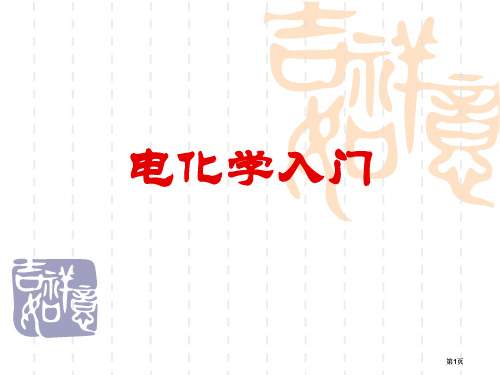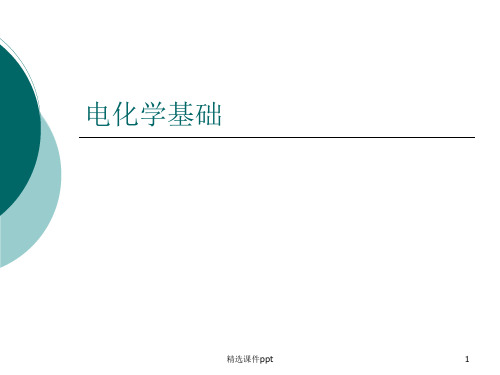麻省理工电化学教程系列1
电化学原理第一章+绪论 PPT课件

电子 流向
导线
负极 →正极
电源负极→电解池阴极 电解池阳极→电源正极
电化学体系的定义
The definition of the electrochemical system
电极反应:电极/溶液界面(两类导体界面)发生 的电化学反应。
电化学反应:在电化学体系中发生的氧化还原反应。 电化学体系:两类导体串联组成的,在电荷转移
3.贾铮、戴长松、陈玲编著:《电化学测量方法》,化学工业出版社 ,2006。
4.努丽燕娜、王保峰主编:《实验电化学》,化学工业出版社,2007 。
5.郭鹤桐编著:《电化学教程》,天津大学出版社,2000。 6.胡会利、李宁主编:《电化学测量》,国防工业出版社,2007。 7.查全性等编:《电极过程动力学导论》(第二版),科学出版社,
金属腐蚀的种类
The types of metal corrosion
种类 化学腐蚀
电化学腐蚀
条件
例如 电流
金属与非电解质 等直接发生化学 反应
2Fe+3Cl2=2FeCl3
无
不纯金属或合金跟 电解质溶液接触发 生原电池反应
钢铁腐蚀
有微弱的电流
本质 金属被氧化 较活泼金属被氧化
相互 关系
化学腐蚀、电化学腐蚀常同时发生
(2)在金属表面覆盖保护层 ——电镀、油漆、钝化等
(3)电化学保护法 ——牺牲阳极的阴极保护法、 外加直流电源的阴极保护法
1.3 电化学科学的发展简史和发展趋势
1.3.1电化学科学的发展简史 1.3.2 电化学的发展趋势
1.3.1电化学科学的发展简史
brief development history of electrochemical science
《麻省理工开放课程:电路与电子学》6002Lec01中文讲义

15
必须被定义。
若
仅仅在灯丝内当
时是正确的。
6.002 2000 年秋 第一讲
16
6.002 2000 年秋 第一讲
17
6.002 2000 年秋 第一讲
18
6.002 2000 年秋 第一讲
19
那么,这给我们带来什么好处呢?
使用集总电路抽象(LCA),以简单的代数代 替了微分方程。
例如:
1
课前说明:
讲师:Prof. Anant Agarwal ■ 教材:Agarwal&Lang(A&L) ■ 仔细阅读所发资料第三页 ■ 课程任务:
课后作业练习 实验 随堂考试 期末考试
6.002 2000 年秋 第一讲
2
■ 作业中可有两次不做(作业 11 除外) ■ 对互相协作的要求
课后作业 可以与其他人合作,但不准抄袭
6.002 2000 年秋 第一讲
10
简单的方法……
这样,为了计算电流我们以 一个独立电阻
来代替灯泡。
R 代表我们唯一感兴趣的特性。 就像质点:用质量 m 代替物体来求得
6.002 2000 年秋 第一讲
11
简单的方法……
R 代表我们唯一感兴趣的特性。 R 元件的电压和电流有以下关系:
称为元件的伏安关系特性
在集总问题规定下,电压循环一周满足什么关 系呢?
6.002 2000 年秋 第一讲
20
在集总问题规定下,电压循环一周满足什么关 系呢?
基尔霍夫电压定律:(KVL) 集总参数电路中延任一回路电压之和为零
6.002 2000 年秋 第一讲
21
电流有什么特性呢?
考虑
6.002 2000 年秋 第一讲
电化学研究-1

1 电化学的基本概念和理论
1.2.2 法拉第定律
(1)法拉第常数 F 1 mol电子所带的电量称为法拉第常数,用F表示。
F = NAe0 = 6.022 136 7×1023×1.602 177 33×10-19 = 96 485.309 C· mol-1
式中, F—法拉第常数(Faraday constant), C· mol-1 NA—阿伏伽德罗常数(Avogadro’s number), 6.022 136 7×1023 mol-1 e0—1.602 177 33×10-19 C 在一般计算中,可近似取 F=96 500 C· mol-1 1 F = 96 485 C· mol-1 = 26.8 A· h· mol-1
Zn2+ + 2e = Zn
还伴随着其他副反应的发生,如
2H+ + 2e = H2
如果把这两个反应的产物加在一起,则仍为1克当量,符合法 拉第定律。
1 电化学的基本概念和理论
又如,在电解食盐水溶液时,阳极反应为 2Cl- -2e = Cl2 当电极上通过1法拉第电量时,常常得不到1克当量Cl2,这是因 为在阳极生成的Cl2又部分地溶解在电解液中,形成次氯酸盐。 Cl2 + 2NaOH = NaCl + NaClO + H2O 电极反应产物又进一步转化为其它物质的反应,称为次级反应。
m It n It M ZF
1 电化学的基本概念和理论
MIt m ZF
式中,n—电极上发生变化的量,g m—电极上发生变化的质量,g M—物质的摩尔质量,g· mol-1 Z—电极反应中电子的计量系数 F—法拉第常数,96 500 C· mol-1 I—通过电极的电流,A t—反应时间,s 法拉第定律适用于任何温度和压力下的水溶液、非水溶液及熔融 盐的电解过程,而且实验愈精确,所得结果与法拉第定律愈吻合。
电化学入门公开课一等奖优质课大赛微课获奖课件

接电源负极电极反应 2H+ + 2e- → H2
总反应
H2O → 1/2 O2 + H2
第4页
电极名称
▪ 从溶液流进电子电极叫做阳极。 ▪ 流出电子电极叫做阴极。
称呼
电子移动情况
反应 别称-电解体系 别称-电池体系
阳极
电极 溶液 Red还原体
▪ 能够溶解不溶于水物质。 ▪ 有些反应生成物在水溶液中会和水分子发
生反应,但在有机溶剂中都能够稳定存在。 ▪ 能在比水溶液体系含有更大电位、pH值和
温度范围内进行反应和测定。 ▪ 依据溶质溶解后状态和反应性质改变,选
择相应溶剂。
第20页
有机溶剂应含有条件
▪ 可溶解足够量支持电解质。 ▪ 含有足够使支持电解质离解介电常数(普通希望
依据能斯特方程式可写为:
E = -0.059 pH E = 1.23-0.059 pH
水稳定区,或者叫做水热力学电位窗口。
第13页
产生氢气实际电位偏离热力学理论值现象
叫
做氢过电位。
氢过电位主要参数是互换电流密度 (i0)。
一系列金属氢过电位,从小到大能够列成下列序列: Pt, Pd, Ru, Rh, Au, Fe, Co, Ag, Ni, Cu, Cd, Sn, Pb, Zn, Hg
第10页
电化学测定办法长处
▪ 测定简朴——能够将普通难以测定化学量 直接变换成容易测定电参数加以测定。
▪ 测定灵敏度高——由于电化学反应是按法 拉第定律进行,因此,即使是微量物质改 变也能够通过容易测定到电流或电量来进 行测定。
▪ 即时性——利用上述高精度特点,能够把 微反应量同时检出,并进行定量。
麻省理工电化学教程系列2

I. Equivalent Circuit ModelsLecture 2: Electrochemical Energy ConversionMIT StudentGalvanic cells convert different forms of energy (chemical fuel, sunlight, mechanical pressure, etc.) into electrical energy and heat. In this lecture, we are interested in some examples of galvanic cells.Current Chemical fuelSunlightMechanicalpressure……1. Voltage Sources1.1 Polymer Electrolyte Membrane (PEM) Fuel CellPEM fuel cells employ a polymer membrane to move ions from anode to cathode. Figure 2 shows the structure of Hydrogen-oxygen PEM fuel cell. Hydrogen molecules are oxidized to protons at the anode. Electrons travel through an external load resistance. Protons diffuse through the PEM under an electrochemical gradient to the cathode. Oxygen molecules adsorb at the cathode, are reduced and react with the protons to produce water. The product water is absorbed into the PEM, or evaporates into the gas streams at the anode and cathode. The detailed reactions areFigure 1: Energy Conversion of Galvanic CellH2 O2gas gas2OResistorAnode (oxidation reaction, produces electrons):Cathode (reduction reaction, consumes electrons):Net reaction:The equivalent circuit of PEM fuel cell is shown in Figure 3. The resistors and capacitors are related to different effects:R a D: gas diffusion at anodeR c D: gas diffusion at cathodeR a i: interfacial charge transfer at anodeR c i: interfacial charge transfer at cathodeR M: ion transfer in membraneC a i: interfacial charge storage at anodeC c i: interfacial charge storage at cathodeFigure 2: Hydrogen-oxygen PEM fuel cella c0 R ext1.2 Solid Oxide Fuel Cell (SOFC)Solid oxide fuel cells are a class of fuel cell characterized by the use of a solid oxidematerial as the electrolyte. In contrast to PEM fuel cells, which conduct positive hydrogen ions (protons) through a polymer electrolyte from the anode to the cathode, the SOFCs use a solid oxide electrolyte to conduct anions, e.g. negative oxygen ions, from the cathode to the anode, as shown in Figure 2. The electrochemical oxidation of the oxygen ions thus occurs on the anode side. The detailed reactions areAnode (oxidation reaction, produces electrons):Cathode (reduction reaction, consumes electrons):Net reaction:Figure 3: Equivalent circuit of PEM fuel cellH 2O 2gas gasH 2 Resistor2. Current Sources2.1 Silicon p-n Junction Solar CellBefore we learn silicon solar cell, we need to understand some basic concepts of semiconductor physics.A fundamental result of solid-state physics states that in semiconductor electrons with specific energies are allowed to stay in sharply define bands leaving bandgaps of forbidden energies in between. As shown in Figure 5, the two key bands around the fundamental bandgap are given special names. The band immediately below is called the valence band while the band immediately above is called the conduction band. In pure silicon, all states in valence band are occupied by electrons while all states in conduction band are empty at temperature of 0 K. At high temperatures a few states of the conduction band may actually be occupied by electrons. The electrons in the partially filled conduction band can move around in response to an applied voltage. In addition, there are empty states, called holes, in valence band which now allow electrons to move about.The band structures of silicon can be changed by doping. Doping brings foreign atoms which do not change the silicon lattice very much but can donate or accept electrons. The atom from Column V of the periodic table can “donate” one of its electrons to the conduction band and become positively charged, which is called donor. The semiconductor with doped donors is call n-type semiconductor. The atom from Column III of the periodic table can “accept” abonding electron and become negatively charged, which is called acceptor. The semiconductorFigure 4: Solid oxide fuel cellwith doped acceptors is call p-type semiconductor. Electron states associated with donor and acceptor atoms can be represented in the energy band diagram as shown in Figure 6. Donor states are inside the forbidden gap slightly below the conduction band edge at E D . The reason is that it only takes a small amount of energy to release the electron the conduction band. Similarly, acceptor states are represented slightly above the valence band at E A , as a little energy will result in the release of a hole to the valence band.Egg(E)Figure 5: Band structure of Intrinsic Si at 0KFigure 6: Band structure of doped Si. (a) n type. (b) p type.An ideal p-n junction is a semiconductor structure where the doping level abruptly changes from n-type with a uniform donor concentration to p-type with a uniform acceptor concentration,shown in Figure 7. Electrons on the n-side will tend to flow towards the p-side since they are presented with empty states at the same energy. At the same time, holes on the p-side will flow towards the n-side where there are lots of available states at the same energy. Once thermal equilibrium has been established and charge redistribution has stopped, a charge dipole has developed across the junction. This results in net positive charge on the n-side and net negation charge on the p-side. So there is a build-in electric field at the junction.When the p-n junction absorb a photon with hv>E g, a new electron-hole pair is produced. The build-in electric field drives the electron to the n-side and the hole to the p-side. If we connect the p-n junction to the external circuit, we will “harvest” the electron-hole pair current at electrodes.lightR extFigure 7: p-n junction solar cellThe equivalent circuit of p-n junction solar cell is shown in Figure 8(a). A p-n junction diode is in parallel with a current source where I p is the photocurrent. Figure 8(b) shows the I-V curve of the diode. In forward bias, large current is easy to pass. But in reverse bias, only a small saturation current I s is allowed. The I-V relation of diode can be calculate asAssuming R int=0, the I-V relation isp =0 (dark environment), the solar cell performs as a diode. When I p>0 (light environment), the open circuit voltage isI D V I Dsreverse biasforward bias (a) (b) VI p >0V 0I p =0I p +I s0 I s I p IFigure 8: Equivalent circuit of p-n junction solar cellFigure 9: Current-voltage relation of p-n junction solar cell2.2 Graetzel Cell (dye-sensitized solar cell)A dye-sensitized solar cell is based on a semiconductor formed between a photo-sensitized anode and an electrolyte, as shown in Figure 10. The cell has three primary parts. On the top is a transparent anode made of fluorine-doped tin dioxide (S n O2:F) deposited on the back of a (typically glass) plate. On the back of the conductive plate is a thin layer of titanium dioxide(T i O2), which forms into a highly porous structure with an extremely high surface area. T i O2 only absorbs a small fraction of the solar photons. The plate is then immersed in a mixture of a photosensitive ruthenium-polypyridine dye and a solvent. After soaking the film in the dye solution, a thin layer of the dye is left covalently bonded to the surface of the T i O2. A separate backing is made with a thin layer of the iodide electrolyte spread over a conductive sheet, typically platinum metal.Sunlight enters the cell through the transparent S n O2:F top contact, striking the dye on the surface of the T i O2. Photons striking the dye with enough energy to be absorbed will create an excited state of the dye, from which an electron can be "injected" directly into the conduction band of the T i O2, and from there it moves by diffusion (as a result of an electron concentration gradient) to the clear anode on top. Meanwhile, the dye molecule has lost an electron and the molecule will decompose if another electron is not provided. The dye strips one from iodide in electrolyte below the T i O2, oxidizing it into triiodide. This reaction occurs quite quickly compared to the time that it takes for the injected electron to recombine with the oxidized dye molecule, preventing this recombination reaction that would effectively short-circuit the solar cell. The triiodide then recovers its missing electron by mechanically diffusing to the bottom of the cell, where the counter electrode re-introduces the electrons after flowing through the external circuit.R extFigure 10: Dye-sensitized solar cellFigure 11 shows the equivalent circuit of dye-sensitized solar cell. The basic idea is still the same: “harvest” the electron-hole pairs from the absorbed photons.0 c 02.3 Electro Kinetic Energy ConversionA pressure-driven fluid flow through micro channels carries a net electrical charge with it, inducing both a current and a potential when the charge accumulates at the channel ends. These so-called streaming currents and streaming potentials can drive an external load and therefore represent a means of converting hydrostatic energy into electrical power, as shown in Figure 12. The notion of employing such electro kinetic effects in an energy conversion device is called electro kinetic energy conversion. Physical modeling of electro kinetic energy conversion is needed to guide the optimization of these properties. The relations of electro kinetic phenomena can be described by the following equations:where P is pressure, Q is flow rate, V is voltage and I is current. K H is hydrodynamicconductivity of the porous material, K E is electric conductivity and S is electro kinetic coupling.The detailed model of electro kinetic energy conversion will be discussed in Lecture 33.R extFigure 11: Equivalent circuit of dye-sensitized solar cellFigure 12: Electro Kinetic Energy ConversionMIT OpenCourseWare10.626 / 10.462 Electrochemical Energy SystemsSpring 2011For information about citing these materials or our Terms of Use, visit: /terms.。
《电化学基础课件》第1章 电解质溶液的性质和行为

t
t
Q Q
Q Q
1
精选课件ppt
17
t
I I
U U U
t0,
U0, U0, U0,
t
I I
U U U
t0,
U0, U0, U0,
t0,
0, 0, 0,
0, 0
t0,
0, 0, 0,
0, 0
精选课件ppt
18
1.4 强电解质溶液的静电理论
强电解质溶液的离子互吸理论概述
经典电离学说:假设弱电解质在溶液中“部分电离” 。 对于强电解质,谈不上“部分解离成离子”和电离度 等问题。该学说完全忽略了溶液中离子间的相互作用, 无法解答强电解质在稀溶液中的“当量电导与浓度的 平方根呈线性关系”这一实验事实。
由于离子迁移的速度随温度升高而加快,所以 离子导体的导电能力随着温度升高而增大。
精选课件ppt
6
1.1 导体的分类
半导体——不同于上述两类导体
靠电子导电 或靠空穴导电 其导电能力随温度升高或受光的照射而增大。
精选课件ppt
7
1.2 电解定律
法拉第在总结大量实验的基础上,于1833年 得出两条基本规律:
精选课件ppt
24
静电理论在强电解质活度系数上的应用
活度和活度系数
a vv v v
m
注意活度的定义…
电化学基础
精选课件ppt
1
课程的主要内容(*为核心内容)
第1章 电解质溶液的性质和行为 第2章 电动势与电极电位 第3章* 电极与溶液界面结构与性质 第4章* 电极过程与电化学测试技术 第5章* 液相传质动力学 第6章* 电荷传递动力学 第7章* 气体电极过程 第8章 金属的电沉积 第9章 金属的阳极过程
电化学原理第一章绪论

子定向排列,这样的结果破坏了水层的 四面体结构,离子不能裸露存在。
电化学原理第一章绪论
离子水化产生两种影响 : 溶剂对溶质的影响:离子水化减少溶液
中自由分子的数量,同时增加离子的体 积; 溶质对溶剂的影响:带电离子的水化破 坏附近水层的四面体结构,改变邻近水 分子层的介电常数。
电化学反应:在电化学体系中发生的氧 化还原反应。
电极反应:电极/溶液界面(两类导体界 面)发生的电化学反应。
电化学原理第一章绪论
阳极(anode):发生氧化反应的电极 原电池(-)电解池(+)
阴极(cathode):发生还原反应的电极 原电池(+)电解池(-)
电化学原理第一章绪论
三. 电化学研究的内容 第一类导体 第二类导体 界面结构与性质 界面反应(电化学反应)动力学
电化学原理第一章绪论
三. 水化热 一定温度下,1mol自由气态离子由
真空进入大量水中形成无限稀溶液时的热 效应称为离子的水化热。
电化学原理第一章绪论
水化热特点: 加合性:已知某离子水化热与相应电解
质水化热时可求另外离子的水化热。 不能直接测量某个单个离子的水化热。
电化学原理第一章绪论
四. 水化膜与水化数 水化膜:离子与水分子
电化学原理第一章绪论
液态水是由大小不等的缔合体与自 由水分子组成的缔合式液体;固态水(冰) 是以氢键缔合成正四面体晶体。温度升高 时,氢键破坏,晶体分裂为大小不等的缔 合体 。
电化学原理第一章绪论
二. 电离与离子水化
电解质溶于水时,同时存在两种变化: 电离作用:中性原子或分子形成能自由
移动的离子的过程。 水化作用:物质与水发生化合叫水化作
电化学基础教程(第二版)

电化学基础教程(第二版)版权页•内容提要•前言•第一版前言•第1章绪论•1.1 电化学简介•1.2 电化学的历史•1.3 电化学研究领域的发展•1.4 本书结构与学习方法•复习题•第2章导体和电化学体系•2.1 电学基础知识•2.2 两类导体的导电机理•2.3 电化学体系•2.4 法拉第定律•2.5 实际电化学装置的设计•复习题•第3章液态电解质与固态电解质•3.1 电解质溶液与离子水化•3.2 电解质溶液的活度•3.3 电解质溶液的电迁移•3.4 电解质溶液的扩散•3.5 电解质溶液的离子氛理论•3.6 无机固体电解质•3.7 聚合物电解质•3.8 熔盐电解质•复习题•第4章电化学热力学•4.1 相间电势与可逆电池•4.2 电极电势•4.3 液体接界电势•4.4 离子选择性电极•复习题•第5章双电层•5.1 双电层简介•5.2 双电层结构的研究方法•5.3 双电层结构模型的发展•5.4 有机活性物质在电极表面的吸附•复习题•第6章电化学动力学概论•6.1 电极的极化•6.2 不可逆电化学装置•6.3 电极过程与电极反应•6.4 电极过程的速率控制步骤•复习题•第7章电化学极化•7.1 电化学动力学理论基础•7.2 电极动力学的Butler-Volmer模型•7.3 单电子反应的电化学极化•7.4 多电子反应的电极动力学•7.5 电极反应机理的研究•7.6 分散层对电极反应速率的影响——ψ1效应•7.7 平衡电势与稳定电势•复习题•第8章浓度极化•8.1 液相传质•8.2 扩散与扩散层•8.3 稳态扩散传质规律•8.4 可逆电极反应的稳态浓度极化•8.5 电化学极化与浓度极化共存时的稳态动力学规律•8.6 流体动力学方法简介•8.7 电迁移对扩散层中液相传质的影响•8.8 表面转化步骤对电极过程的影响•复习题•第9章基本暂态测量方法与极谱法•9.1 电势阶跃法•9.2 电流阶跃法•9.3 循环伏安法•9.4 电化学阻抗谱•9.5 滴汞电极与极谱法•复习题•第10章实际电极过程•10.1 电催化概述•10.2 氢电极过程•10.3 氧电极过程•10.4 金属阴极过程•10.5 金属阳极过程•复习题•附录标准电极电势表(298.15K,101.325kPa)•习题答案•参考文献•符号表。
- 1、下载文档前请自行甄别文档内容的完整性,平台不提供额外的编辑、内容补充、找答案等附加服务。
- 2、"仅部分预览"的文档,不可在线预览部分如存在完整性等问题,可反馈申请退款(可完整预览的文档不适用该条件!)。
- 3、如文档侵犯您的权益,请联系客服反馈,我们会尽快为您处理(人工客服工作时间:9:00-18:30)。
I. Equivalent Circuit ModelsLecture 1: Basic Physics of Galvanic CellsMIT Student (and MZB)In this lecture, we give an overview of electrochemical cell operations, and define basic terminologies frequently used in a discussion of electrochemical cell operations.1. Electrochemical Cells and Their OperationsFaradaic Reaction : An electrochemical reaction that involves charge transfer Electrochemical Cell : Two half reactions involving charge transfer, connected via anelectrolyte (conducting ions) and an external circuit (conducting electrons)Figure 1. Galvanic Operation of an Electrochemical CellIn a galvanic cell, electrons and ions flow spontaneously, converting chemical energy into electrical energy (and heat). As shown in Figure 1, in galvanic cell operation, an oxidation reaction occurs at anode, producing electrons. On the other hand, at cathode, a reduction reaction occurs, consuming electrons on the electrode surface. Since the electrons are not able to move through the electrolyte, they flow via external circuits from anode to cathode, making a currentin a direction from cathode to anode. In electrolyte phase, oxidized species migrates from anode to cathode, and reduced species migrates from cathode to anode in net amount, respectively. Inan electrolytic cell , charges flow in the opposite direction, driven by an external voltage which inputs electrical energy to be stored as chemical energy. The sign convention of current is defined to have a positive sign for galvanic cells. Therefore, in an electrolytic cell operation, a current has a negative value.The followings are two examples of electrochemical cell construction: Example 1: PEM fuel cellAnodeCathode H2g→2H++2e−Net Reaction 12O2g+2H+ +2e− →H2O l H2g+12O2gElectrolytepolymer electrolyte membrane (PEM)→ H2O l Example 2: Li-ion batteryAnodeCathode LiC6→ Li++e−+C6Net ReactionLi++e−+CoO2→LiCo O2Electrolyte Li organic liquid containing LiPF C6+CoO2→LiCoO2+C6(“rocking chair battery”) 6 salt dissolved2.Equivalent CircuitIt is possible to represent an electrochemical cell using an equivalent circuit model. We will learn how to model physical components of an electrochemical cell with circuit element representations later on in this course. For now, we focus on operation behaviors of circuits, given an equivalent circuit model of an electrochemical cell.A galvanic cell can be represented by an equivalent circuit as following:Figure 2. An Equivalent Circuit Model of a Galvanic Cellwhere VaoVco : Standard Equilibrium Half-cell Potential of Anode : Standard Equilibrium Half-cell Potential of CathodeRa Rc : Interface Resistance at Anode : Interface Resistance at CathodeRel x Resistance through ElectrolyteRe t :: External Circuit ResistanceEquivalently, the above equivalent circuit may be simplified by lumping circuit elements into fewer representative elements.Figure 3. Lumped Equivalent Circuit Model of a Galvanic CellWhereVo=Vco−VaoRint =Ra+Rel+ Ra : Open Circuit Voltage (OCV) of a Cell : Internal ResistanceNote that standard equilibrium half-cell potentials (Vao , and Vco ) are sometimes denoted electrochemistry, but that notation is refrained since it may be confusing with an electric field. The standard equilibrium half-cell potentials may be either positive or negative, as long as Eo open circuit voltage, is positive (for a galvanic c Vo in , ell).According to the Kirchhoff’s law, (1) where V is the cell voltage . The cell voltage is a function of current, I, state of charge, Q, which will be defined in Lecture 3, and other electrochemical variables. The cell voltage, inthermodynamic terms, means the free energy difference of net cell reaction per chargetransferred. The thermodynamic interpretation of cell voltage will be discussed in Lecture 7.(2)When the external resistance is zero, we obtain short circuit current :(3)Given a current and a cell voltage, we can calculate a cell power, P, which is electrical work done by cell per unit time.(4) Assuming a constant internal resistance, the dependence of cell voltage and cell power to the current can be plotted as following:Electrolytic Galvanic Super GalvanicRegime Regime RegimeP < 0 P > 0 P < 0I < 0 I > 0 I > I SV > V o0 < V < V o V < 0Electrical Energy Chemical Energy Chemical + Electrical Energy→ Chemical Energy Storage → Electrical Energy + Heat Loss → Heat Losse.g. charging a Li-ion battery e.g. discharging a battery e.g. forcing the battery toby applying a reverse through an external load discharge faster than I S byvoltage applying a voltage externally Figure 4. Cell Voltage and Power Behavior as a Function of CurrentTable 1. Different Regimes of Cell Operation and FeaturesMore realistic fuel cells do not have constant internal resistance. Rather, they have nonlinear contributions from several overpotential components. Overpotential refers to the magnitude of potential drop caused by resistance to the passage of current. We will learn their behaviors and interpretations through this course.Cell voltages of typical fuel cells show the following dependence on current. With a small current, activation overpotential dominates and gives the concave curve in the beginning. Following that, the resistance from either electron or ion transport becomes the limiting factor, giving the linear curve in the middle. Lastly, when current is large enough, transport of fuel cannot sustain the current, and the cell voltage drops quickly.Figure 5. Cell Voltage of Typical Fuel Cells as a Function of CurrentMIT OpenCourseWare10.626 / 10.462 Electrochemical Energy SystemsSpring 2011For information about citing these materials or our Terms of Use, visit: /terms.。
